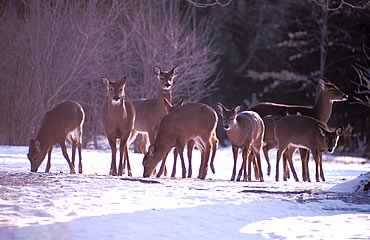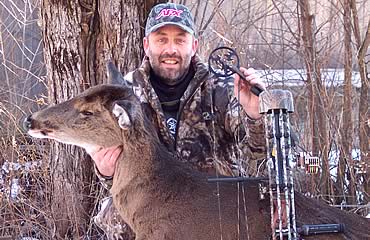Bucks get all our attention, but the life and habits of does are just as interesting.
The afternoon’s first hours passed slowly and uneventfully, as they so often do. I could almost feel the temperature drop when the sun disappeared behind the treetops. That’s when I heard the first distant footfalls pattering on the crusty snow. Scanning the thick evergreens, I spied first one, then another brown shape moving through a copse of balsam fir. Two deer eventually turned into five as they slowly made their way in my general direction. My body began to shake from the excitement and the sudden awareness of how cold I was.
Two young does started forward from cover then stopped, looking back over their shoulders as if one of the other deer had called to them. I couldn’t see its head, but the body was massive. “Gotta be a buck,” I thought. Part of me hoped it was. I’d certainly put in my time on this stand and felt I should be rewarded.
On the other hand, that wasn’t why I was there. The landowner, an older woman, had grown tired of the deer ravaging her landscaping. She contacted the local state wildlife biologist who then contacted me and offered the job of culling the offending animals. The objective was to remove any deer and many deer, and I knew that would best be accomplished by concentrating on does.
Four of the five deer milled about restlessly while the sixth, the big-bodied one, stood stock still, staring intently ahead. Then the deer flicked its tail and stepped forward, revealing a huge antlerless head. That was the signal the other deer had been waiting for, and they quickly moved forward and filed past my stand. I stayed focused on what was obviously the leader of this doe group as she moved cautiously forward and stopped at 25 yards.
For several tense minutes, she stood facing me, never offering a clean shot. She must have sensed something, for she stomped her foot once and slowly turned back in the direction from which she’d just come. She hesitated for just a second, long enough for me to draw, center on her chest and touch my release. The arrow zipped cleanly through her chest, and the big doe made several bounds, stopped and fell over.
Walking up to her, the first thing I noticed was her head — it was huge — and her long nose. I later aged her at 6 1/2 years, ancient for such a heavily populated and heavily hunted area. She was the only deer I killed on the property that winter, but from that day on, the depredation problems ceased.
 That old matriarch demonstrates just one of the many reasons why does are so important.
That old matriarch demonstrates just one of the many reasons why does are so important.
She was the leader of her social group. On a larger scale, does in general have a much greater influence over how deer behave and where they travel than bucks do, particularly during certain times of the year. Learning their habits is often easier and can be far more beneficial than trying to pattern a buck. Find the does, and odds are good the bucks won’t be far away.
Summer to Fall: A Period of Transition
As summer draws to a close, the diminishing of daylight hours is more obvious. Whitetail physiological and behavioral changes are happening at a faster pace. You might recall from last month’s “A Buck’s First Year” that maternal does start the summer being territorial and secretive, but gradually expand their home range and become more tolerant of other deer. In fact, they associate more and more with other does and their offspring — some of which are likely to be her children and grandchildren — to form what we sometimes call doe groups.
Deer society, if there is such a thing, is matriarchal, which means it’s run by a dominant doe. Ole Hatrack might be the king of the forest, but it’s his queen who really runs the show. Within doe groups (which also include young antlerless bucks) there is a social hierarchy. One doe dominates all others. Below her there is a somewhat looser pecking order of descending dominance.
One reason this hierarchy is not more structured is probably because these doe aggregations are fairly loose. Smaller family groups consisting of a doe and her fawn or fawns might come and go, joining and leaving the larger group on a fairly regular basis. Family groups might separate and bed in different locations during the day, then reunite in a feeding area in the afternoon. They might feed in one place one day and another the next; much depends on the quality and quantity of available food.
Most folks don’t realize it, but nutritionally, late summer can be a critical period for deer, especially does. All spring and summer they have been nursing one, two or, in rare occasions, three fawns. To do so, the doe needs a high-protein diet. As the fawns get bigger, they require more food. But as we hit late summer, plants begin to ripen and die, and their protein content drops. In economic terms, demand is at its peak while supply is rapidly diminishing.
Fortunately, there are solutions. Through late summer, does have been weaning their young. This helps reduce the protein burden on the mother. Food plots can also benefit deer during this crucial period, providing they address the appropriate dietary needs.
 Company
Company
Up to this point, deer have been mostly sexually segregated into doe groups and bachelor herds. The bucks that have been solitary or in small bachelor groups are becoming more social. Whether it’s a breakdown in social intolerance, a greater demand for food, or merely a coincidence, more and more the bucks and does are associating with one another. They’re analogous to little kids. Boys and girls play together, and there’s no sexual tension, yet.
Fall
Fall brings with it a chill in the air that seems to signal a sense of urgency in does. Instinctively, they know it’s time to put on fat ahead of the impending winter. Feeding becomes increasingly less casual and occupies a growing portion of a doe’s daily routine. Meanwhile, food is becoming more scarce, so a doe and her fawns must travel farther and be on their feet longer, which makes them more vulnerable.
A doe’s diet changes, too. While weaning her fawns, a doe will gradually shift away from proteins like clover and alfalfa toward foods with higher carbohydrate content, like hard mast. She and her minions spend less time in the fields and more time on oak ridges or in oak bottoms.
Her movement patterns are changing for another reason as well. Increasingly, she’s detecting a foreign, but not entirely unfamiliar, presence in the woodlot. A combination of instinct, experience and learning have made her cautious of human scent. Like all wild creatures, she’s naturally wary of something new and unusual. Her mother likely reinforced that wariness around humans, and she will teach this to her offspring. And in four-plus years, she no doubt learned from negative encounters. Unlike a buck, that has to look out only for itself, she’s watching out for three. As a result, she is now the most cautious creature in the woodlot: a mature doe.
A Change in the Wind
Other changes are in the wind. In addition to human scent, there seems to be more deer scent in the woods. Increasingly, a doe encounters patches of bare earth that smell strongly of buck urine and tarsal glands. At first, she ignores them. In time, she becomes more curious.
These odors and, more importantly, the decreasing hours of daylight trigger hormonal changes. She starts to get more attention from the bucks in the area. Instead of passing by, they come closer, perhaps even following her for a few steps. This makes her anxious and more agitated, so she becomes more reclusive.
One day she rises, and something’s different. She might not even recognize it, but the bucks do; her scent has changed. Instead of short visits, the bucks dog her relentlessly, weaving like cutting horses and grunting like pigs.
A yearling buck chases her throughout the morning until she runs into a powerful stream of man scent. There’s a clap like thunder, and her suitor follows no more. He’s soon replaced by another, older buck that chases her until she tires; but he doesn’t seem to know what to do when he catches her.
The next day, several bucks lie bedded near the doe’s favorite thicket. Some time in the night, two of them paired off in a tremendous brawl. The vanquished buck is badly scarred. His lip is torn, and he nearly lost an eye. The victor is not much better off. Both are physically exhausted and unaware that, during the heat of battle, the doe slipped away.
Our doe rises to feed and whips her head around as she hears footsteps slowly approaching —another buck. This one is mature. Instead of the sleek build of a racehorse, his is like a bull; heavy neck blending seamlessly into his dense chest. Rather than charging in heedlessly, he stands and stares, bowing his head, curling his upper lip and sucking in air, which he draws past the vomeronasal organ on the roof of his mouth. He steps deliberately toward the doe, exuding dominance. This time, she does not run away.
He follows her the rest of that day, never letting her out of his sight, except twice when he chases off younger rivals. Unlike the younger bucks that charged in, he approaches her slowly but deliberately, which seems to put her more at ease. She steps away, but each approach brings him closer until, finally, she stands for him. The pair unite briefly, and the seeds for next year’s fawns are sewn.
The buck peels off in search of another mate. He needs to act quickly. Most of the adult does in his woodlot will be receptive only for a few days. While he tended to one doe, several others were already bred by rival or even younger bucks. Within four or five days, the flurry will die down, and the deer will turn their attention back to feeding.
Fall to Winter
Cool days and cold nights turn to cold and colder. Food becomes the top priority for all deer, and they seek out foods with the most calories. Nervousness from relentless pursuit by rutting bucks wanes, and the does regroup. One afternoon in the corner of a bean field, our doe is approached by two younger deer. They sniff one another from a distance, then briefly touch noses. It is the mother and her young, united once again. They’ll spend the rest of the winter and early spring together, until she drives them off to usher in another generation of whitetails.
Read Recent Articles: • New Year’s Eve Bonanza: Talk about waiting until the last minute to make a deer season!
• Burnin’ Down the House: Fire can be scary and dangerous, but controlled burns really help deer habitat.
• Dorothy Was Right: Kansas really is the Land of Oz when it comes to deer hunting.
This article was published in the September 2008 edition of Buckmasters Whitetail Magazine. Join today to have Buckmasters delivered to your home.